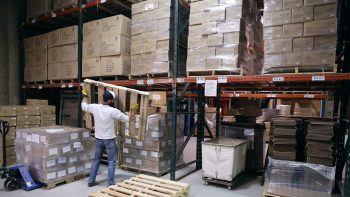
Businesses are breathing new life into unused warehouse space
Businesses are breathing new life into unused warehouse space

Early in the pandemic, businesses quickly realized that warehousing space had become a particularly valuable resource. Supply chains were backed up, consumer demand was off the charts, and retailers and wholesalers alike wanted to cache as many goods as possible in warehouses. As a result, they bulked up the amount of warehouse space they had.
Now, however, supply chains have pretty much returned to pre-pandemic conditions. And storing extra inventory just isn’t as important anymore. That means a lot of businesses have been trying to figure out what to do with all that extra warehousing space.
One of those companies is TMB Baking, a equipment supplier and manufacturer based in south San Francisco. In one of its warehouses, the company stores big, sophisticated baking equipment, including ovens, electric mixers, and metal boxes for storing sourdough starter.
The company imports most of this equipment from Europe. CEO Greg Warwick said back in 2021, when supply chains around the world were congested, the company realized it needed to store a lot more inventory on-site. And Warwick’s landlord happened to have another warehouse available next door.
“We made the decision at that time that it was worth investing some more in the ability to bring that equipment over and inventory it here,” Warwick said.
TMB Baking wasn’t alone. By the second half of last year, the number of warehouses in the U.S. was almost 20% higher than just before the pandemic, according to the Census Bureau.
But now that supply chains have eased up, TMB Baking doesn’t need to store as much inventory. As a result, Warwick decided to repurpose the warehouse into a showroom.
“We saw that there was really the great opportunity to walk people next door and say, ‘hey, here’s your mixer. This is it. And you want to test it?,'” Warwick said. “We can bring it over and plug it in if they need to do that.”
Retailers — especially smaller retailers — aren’t using their warehouses as much as they were a year ago, said Zac Rogers, a professor of supply chain management at Colorado State University who helps put together the Logistics Managers Index, which tracks warehouse utilization.
“Larger firms sold a bunch of stuff during the holidays, and now they’re replenishing inventories,” Rogers said. “Smaller firms, I think, are being a little more cautious.”
Rogers said those business owners know that they can’t just sit on their warehouse space.
“You have to figure out, ‘well, can we sublease part of this? Can we use it for something else?’” Rogers said. “You don’t want to just be paying for a big box full of air, because right now, that big box full of air is pretty expensive.”
Those big boxes of air are expensive, in part, because interest rates are higher. Also, because there’s a lot of demand for their unused warehouse space from companies that don’t even want to store stuff in it.
Karen Yip, broker-owner of Yip Premier Real Estate in Columbia, South Carolina, said her local economy has been booming. A lot of people and businesses have been moving to South Carolina and trying to find places to set up shop.
“Any time a smaller warehouse space comes on the market, it tends to get snapped up pretty quickly,” Yip said.
Yip said that space is getting snapped up by event spaces, breweries and gyms, for instance. That’s because warehouse space tends to be a lot cheaper to rent out than retail storefronts.
“The price per square foot can’t be beat at all,” said David Walker, the owner of CrossFit Lodestar in Lexington, South Carolina. “I looked at places that were a third the size, that were twice the rent.”
Walker moved his gym into a 6,000-square-foot warehouse about a year and a half ago. He said the building works really well for him. There’s plenty of floor space. The roll-up door helps with air flow. And transforming the warehouse into a gym was simple.
“There’s not a lot of permitting I have to go through to get that stuff done,” Walker said. “I just unscrew this, drill another hole here, and it was a blank slate for me, which made it really easy for me to build out.”
Meanwhile, in the Boston area, developers have been snapping up unused warehouses to tear them down and build apartments.
Seth Williams, the owner of Reference Real Estate in Boston, said local governments have been re-zoning a lot of commercial areas to encourage more housing.
“Everyone’s on the prowl for a plot or a warehouse or a box, or something that they can take and really increase density,” Williams said.
Williams said developers have pretty deep pockets, which gives them an edge over businesses that actually need to store stuff.
One of his clients, Jess Harrington, runs a business called JessFinessed, which stages homes that are up for sale. She’s been on the hunt for a warehouse to store all the furniture and accessories she needs.
“I did put an offer in on a place in my neighborhood,” Harrington said. “Unfortunately, the terms were not super desirable to the seller, and so my offer has not been accepted.”
Harrington said she’s building up cash, so that when another warehouse comes on the market, she can make a stronger bid.
There’s a lot happening in the world. Through it all, Marketplace is here for you.
You rely on Marketplace to break down the world’s events and tell you how it affects you in a fact-based, approachable way. We rely on your financial support to keep making that possible.
Your donation today powers the independent journalism that you rely on. For just $5/month, you can help sustain Marketplace so we can keep reporting on the things that matter to you.

















